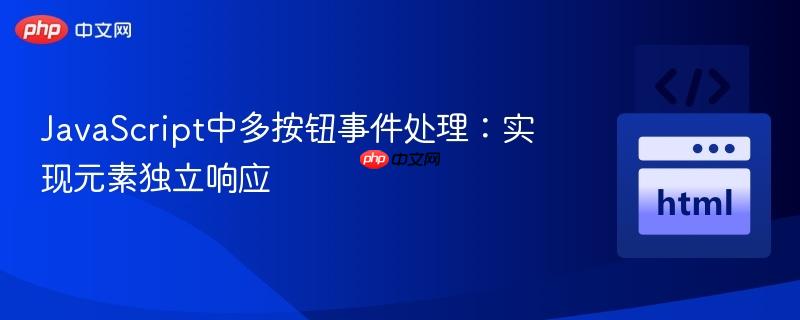
本文旨在解决javascript中多个相似按钮在点击时仅影响第一个元素的问题。通过探讨`document.queryselector`的局限性,文章提供了两种实现元素独立响应的专业方法:一是通过将`this`作为参数传递给事件处理函数,确保每个按钮操作其自身的关联元素;二是通过使用`addeventlistener`和`event.target`,结合`document.queryselectorall`实现更灵活、可维护的事件绑定。文章强调了id的唯一性原则,并提供了详细的代码示例和最佳实践。
在Web开发中,我们经常会遇到页面上存在多个功能相似的交互元素(如按钮),它们需要执行相同的JavaScript逻辑,但各自操作不同的DOM元素。一个常见的陷阱是,当使用document.querySelector配合非唯一ID选择器时,无论哪个按钮被点击,JavaScript代码都只会影响页面上第一个匹配的元素。本教程将深入探讨这一问题,并提供两种专业的解决方案,确保每个按钮都能独立响应其特定的DOM元素。
考虑以下HTML结构和JavaScript代码:
<div> <button id="info" onClick="hideText()"> A button </button> <div class="info-hide" style="display:none;">Copied!</div> </div> <div> <button id="info" onClick="hideText()"> A button </button> <div class="info-hide" style="display:none;">Copied!</div> </div>
function hideText() {
const btn = document.querySelector('#info');
const infoHide = document.querySelector('.info-hide');
infoHide.style.display = "block";
btn.style.display = 'none';
setTimeout(()=>{
btn.style.display = 'block';
infoHide.style.display= "none";
}, 2000);
}上述代码中存在两个主要问题:
解决上述问题的核心在于,让事件处理函数知道是哪个特定的元素触发了事件。在内联的onClick事件中,this关键字指向当前被点击的DOM元素。我们可以将this作为参数传递给hideText函数。
立即学习“Java免费学习笔记(深入)”;
更新HTML:
<div> <button id="info1" onClick="hideText(this);">A button</button> <div class="info-hide" style="display:none;">Copied!</div> </div> <div> <button id="info2" onClick="hideText(this);">A button</button> <div class="info-hide" style="display:none;">Copied!</div> </div>
更新JavaScript:
function hideText(target) {
const infoHide = target.parentElement.querySelector('.info-hide');
infoHide.style.display = "block";
target.style.display = 'none';
setTimeout(() => {
target.style.display = 'block';
infoHide.style.display = "none";
}, 2000);
}更现代和推荐的做法是使用addEventListener来绑定事件。这种方法将JavaScript逻辑与HTML结构分离,提高了代码的可维护性和灵活性。
更新HTML:
<div> <button id="info1" class="smartbutton">A button</button> <div class="info-hide">Copied!</div> </div> <div> <button id="info2" class="smartbutton">A button</button> <div class="info-hide">Copied!</div> </div>
更新JavaScript:
document.addEventListener('DOMContentLoaded', () => {
document.querySelectorAll('.smartbutton').forEach((btn) => {
btn.addEventListener('click', (event) => {
hideText(event.target);
});
});
});
function hideText(target) {
const infoHide = target.parentElement.querySelector('.info-hide');
infoHide.style.display = "block";
target.style.display = 'none';
setTimeout(() => {
target.style.display = 'block';
infoHide.style.display = "none";
}, 2000);
}可选的CSS样式: 为按钮和隐藏文本添加一些基础样式,使其更具交互性。
.smartbutton {
cursor: pointer;
margin-bottom: 1rem;
}
.info-hide {
display: none; /* 默认隐藏 */
}在处理JavaScript中多个相似元素需要独立响应事件的场景时,避免使用非唯一ID和document.querySelector的默认行为是关键。本教程介绍了两种有效且专业的解决方案:
无论选择哪种方法,始终牢记HTML中id属性的唯一性原则,并根据项目需求和团队规范选择最适合的事件绑定策略。推荐使用addEventListener,因为它提供了更强大的功能和更好的代码组织结构。
以上就是JavaScript中多按钮事件处理:实现元素独立响应的详细内容,更多请关注php中文网其它相关文章!

每个人都需要一台速度更快、更稳定的 PC。随着时间的推移,垃圾文件、旧注册表数据和不必要的后台进程会占用资源并降低性能。幸运的是,许多工具可以让 Windows 保持平稳运行。

Copyright 2014-2025 https://www.php.cn/ All Rights Reserved | php.cn | 湘ICP备2023035733号